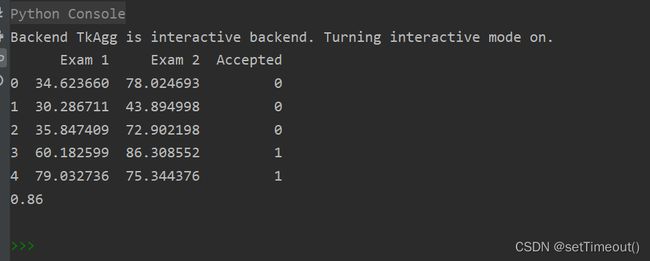- BP神经网络及其Python和MATLAB实现预测
陈辰学长
神经网络pythonmatlab
BP神经网络及其Python和MATLAB实现预测引言BP神经网络(BackPropagationNeuralNetwork),即反向传播神经网络,是一种通过反向传播算法进行监督学习的多层前馈网络。这种网络能够通过不断地调整和改变神经元的连接权重,达到对特定任务的学习和优化。由于其高度的灵活性和适应性,BP神经网络在模式识别、函数逼近、优化问题等多个领域有着广泛的应用。本文将详细介绍BP神经网络的
- 【Python】selenium结合js模拟鼠标点击、拦截弹窗、鼠标悬停方法汇总(使用 execute_script 执行点击的方法)
翠花上酸菜
selenium网络爬虫pythonseleniumjavascript
我们在写selenium获取网络信息的时候,有时候我们会受到对方浏览器的监控,对方通过分析用户行为模式,如点击、滚动、停留时间等,网站可以识别出异常行为,进而对Selenium爬虫进行限制。这里我们可以加入JavaScript的使用。Selenium可以执行JavaScript,通过使用execute_script方法,来执行点击操作。它可以绕过一些Selenium直接操作元素时可能遇到的问题,比
- Conda与Bash的完美融合:激活你的开发环境
2401_85760095
condabash开发语言
Conda与Bash的完美融合:激活你的开发环境在Python开发者的日常工作中,Conda不仅作为包管理器,更是一个强大的环境管理工具。为了在bashshell中使用Conda创建的环境,需要进行初始化操作。condainitbash命令正是为此设计的,它可以修改bash的配置文件,使得Conda的环境能够在每次启动bashshell时自动激活。本文将详细介绍如何使用condainitbash命
- 2024年最全selenium UI使用小技巧集合_python selenium 中
2401_84692253
程序员seleniumuipython
al=driver.switch_to.alertal.send_keys(“口罩太贵了”)al.accept()#确认对话框time.sleep(3)driver.quit()###鼠标事件用selenium做自动化,有时候会遇到需要模拟鼠标操作才能进行的情况,比如单击、双击、点击鼠标右键、拖拽等等。而selenium给我们提供了一个类来处理这类事件——ActionChainsActionCha
- webUI自动化之基本框架搭建(python + selenium + unittest)_python ui自动框架
2401_84140628
2024年程序员学习自动化pythonselenium
先自我介绍一下,小编浙江大学毕业,去过华为、字节跳动等大厂,目前阿里P7深知大多数程序员,想要提升技能,往往是自己摸索成长,但自己不成体系的自学效果低效又漫长,而且极易碰到天花板技术停滞不前!因此收集整理了一份《2024年最新Python全套学习资料》,初衷也很简单,就是希望能够帮助到想自学提升又不知道该从何学起的朋友。既有适合小白学习的零基础资料,也有适合3年以上经验的小伙伴深入学习提升的进阶课
- 【2025年】全国CTF夺旗赛-从零基础入门到竞赛,看这一篇就稳了!
白帽黑客鹏哥
linux网络安全web安全密码学CTF夺旗赛
基于入门网络安全/黑客打造的:黑客&网络安全入门&进阶学习资源包目录一、CTF简介二、CTF竞赛模式三、CTF各大题型简介四、CTF学习路线4.1、初期1、html+css+js(2-3天)2、apache+php(4-5天)3、mysql(2-3天)4、python(2-3天)5、burpsuite(1-2天)4.2、中期1、SQL注入(7-8天)2、文件上传(7-8天)3、其他漏洞(14-15
- Python: Python 多版本管理
mikes zhang
pythonpython大数据pip
PythonLauncherPythonLauncher是PythonforWindows才有的功能.(注一)PythonLauncher的出现,让我们可以不必依赖环境变数PATH的设定来简化python执行档的使用,同时也简化了多个版本的python同时存在时的管理工作.(试想如果你的系统里安装3或4个python时,你到底要如何指定使用其中一个版本?)PythonLauncherpy.exe是
- 【Python】类(class)
shanks66
python开发语言
@[toc]【Python】类(class)【Python】类(class)在Python中,类(Class)是面向对象编程(OOP)的核心概念。类用于创建对象,对象是类的实例。类可以包含属性(变量)和方法(函数),用于描述对象的行为和状态。Python类的基本结构和用法:1.基本语法class类名:#类属性(所有实例共享)类属性=值#构造方法(初始化对象)def__init__(self,参数1
- 大模型介绍
詹姆斯爱研究Java
spring
大模型(LargeModel)指的是拥有庞大参数量的机器学习模型。由于具有更多的参数,大模型能够更好地拟合复杂的数据和模式,从而提供更准确的预测和更好的性能。大模型的参数量通常远远超过常规模型,可以达到数百万甚至数十亿个参数。这些参数通常通过深度神经网络(DeepNeuralNetwork)来表示,包括多个隐藏层和大量的神经元。大模型的训练需要大量的计算资源和数据。通常,它们需要在多个GPU或TP
- 深度解析:Python与TensorFlow在日平均气温预测中的应用——LSTM神经网络实战
AI_DL_CODE
python神经网络tensorflowLSTM气温预测RNN
文章目录1.引言1.1研究背景与意义1.2研究目标与问题定义2.概念解析2.1Python语言简介2.2TensorFlow框架概述2.3LSTM神经网络原理3.原理详解3.1时间序列分析基础3.1.1时间序列的组成3.1.2时间序列分析方法3.2LSTM在时间序列分析中的应用3.2.1LSTM的优势3.2.2LSTM的结构3.3日平均气温预测的数学模型3.3.1ARIMA模型3.3.2LSTM模
- python多版本管理_python 多版本管理
春梅狐狸
python多版本管理
枫癫:您好!我用的是5.7版本,按照您的配置,错误如下麻烦看到了,还请回复,比较着急,谢谢您了!|@|[root@controllerwy]#snmpwalk-v1-cpublic192.168.1.100.1.3.6.1.4.1.2021.5000|@|UCD-SNMP-MIB::ucdavis.5000.1.0=INTEGER:1|@|UCD-SNMP-MIB::ucdavis.5000.2.
- 【python | pip list】pip list导入与导出
苹榆枫
#深度学习框架pippythonlinux
1.导出#查看当前安装的包piplist#导出当前安装的包记录pipfreeze>./requirements.txt2.导入#用anaconda创建一个虚拟环境condacreate-npy37python=3.7#激活当前py37环境MAC/Linux:sourceactivatepy37WIndows:activatepy37#导入安装之前的包列表pipinstall-r./requirem
- 【AI | python】functools.partial 的作用
苹榆枫
#深度学习框架人工智能python
在代码中,partial是Pythonfunctools模块中的一个方法,用于固定函数的某些参数并返回一个新的函数。这个新的函数可以像原函数一样调用,但固定的参数不需要再次提供。代码中:self.compute_cis=partial(compute_axial_cis,dim=self.internal_dim//self.num_heads,theta=rope_theta)这里partial
- 下完安装好python后,想查看python的安装位置的几种方法
omofun5541
python开发语言
查看python的路径基于windows系统,按下win+r(也就是命令提示符),输入cmd,进入查看当前的python的版本的话输入python-V1,查看当前下载的python类型和路径则可以输入py-0(加*的是你使用python的默认版本)2,还可以使用命令wherepython查看路径(这样就不会显示你python默认使用的是哪个)小技巧:如果想清除命令行的话可以输入命令cls然后ent
- Python3 环境搭建指南
lly202406
开发语言
Python3环境搭建指南1.引言Python是一种广泛使用的高级编程语言,以其简洁明了的语法和强大的功能而闻名。Python3是Python的最新版本,它在Python2的基础上进行了大量更新和改进。本指南将详细介绍如何在您的计算机上搭建Python3环境,以便您可以开始编写和运行Python程序。2.系统要求在开始安装Python3之前,请确保您的计算机满足以下最低系统要求:操作系统:Wind
- 【python自动化运维】python第三方运维模块应用
leo__programmer
python自动化运维运维python自动化
一、pymysql模块——数据库编程1、介绍第三方模块作用:连接MySQL数据库1.1、操作流程创建数据库连接基于连接创建游标cursor数据库读写操作关闭游标关闭数据库连接2、pymysql模块的使用2.1、准备工作准备MySQL数据库安装pymysql模块pipinstallpymysql安装配置MySQL数据库[root@localhost~]#yuminstall-ymariadb-ser
- 一文学习python中编码和解码
科雷learning
python编程python开发语言
学习目录1什么是编码和解码2编解码基本原理3python的默认编码4什么是10进制/2进制/8进制/16进制?5python的字符串编解码5.1使用str.encode()编码,str.decode()解码5.2解码的乱码问题5.316进制字符串转为普通字符串6python字符串和unicode类型编码转换什么是编码和解码大家都知道计算机是二进制的世界,计算机系统只能识别数字0和1组成的一串串的数
- Python timedelta 时间间隔
人生重启
Pythonpython
Pythontimedelta对象用于表示时间间隔,可以通过以下方式初始化:指定天、小时、分钟、秒和毫秒:fromdatetimeimporttimedeltatimedelta(days=2,hours=6,minutes=30,seconds=15,milliseconds=500)从总秒数指定:timedelta(seconds=3600)#1hour从日期差指定:end_date=date
- postgrel执行VACUUM报VACUUM cannot run inside a transaction block
dianzufa9403
数据库golangjava
在python脚本里执行:1sql_gp1="VACUUMdwd_access_record_inout_temp"2sql_gp2="deletefromdwd_access_record_inout_temptwheret.indate>(selectnow()::timestamp-interval'36hour')"3conn=gputil.connect(logger,target_ho
- 2024年华为OD机试真题- 英文输入法-(C++/Java/python)-OD统一考试(C卷D卷)
dijkstra2023
华为odc++pythonjava
题目描述主管期望你来实现英文输入法单词联想功能,需求如下:依据用户输入的单词前缀,从已输入的英文语句中联想出用户想输入的单词。按字典序输出联想到的单词序列,如果联想不到,请输出用户输入的单词前缀。注意英文单词联想时区分大小写缩略形式如"don’t"判定为两个单词"don"和“t”输出的单词序列不能有重复单词,且只能是英文单词,不能有标点符号输入描述输入两行首行输入一段由英文单词word和标点构成的
- Python datetime timedelta
Claroja
Python
https://docs.python.org/3/library/datetime.html#timedelta-objectsclassdatetime.timedelta(days=0,seconds=0,microseconds=0,milliseconds=0,minutes=0,hours=0,weeks=0)timedelta对象基本介绍classdatetime.timedelta
- 【Python】Python-JOSE:Python 中的 JSON Web Token 处理库
@Unity打怪升级
Pythonpythonjson人工智能前端开发语言开源机器学习
Python-JOSE是一个用于处理JSONWebToken(JWT)和JOSE(JSONObjectSigningandEncryption)标准的Python库。它支持对JWT进行签名、加密、解密和验证等操作,是处理基于OAuth2.0和OpenIDConnect协议的身份验证和授权任务的理想选择。Python-JOSE实现了JOSE规范中定义的JWS(JSONWebSignature)、JW
- 【Python】bpython:增强版 Python 交互式解释器
@Unity打怪升级
Pythonpython开发语言人工智能开源软件开源ipythonpip
bpython是一个增强版的Python交互式解释器,它为开发者提供了更加友好和高效的交互体验。与Python内置的REPL(Read-Eval-Print-Loop)相比,bpython提供了更多实用功能,比如自动补全、语法高亮、实时显示函数签名等,使得编写和调试Python代码变得更加轻松。bpython非常适合初学者学习Python,因为它能够帮助开发者实时了解输入的代码效果,同时对有经验的
- python期末题库和答案,python 期末卷及答案
www55597
人工智能
大家好,给大家分享一下python期末题库和答案,很多人还不知道这一点。下面详细解释一下。现在让我们来看看!6.foriinrange(2,n):ifn%i==0:breakifi==n-1:print('是素数')else:print('不是素数')7.'abcabcabc'.count('abc')的值为__3__。8.对于有else子句的for循环和while循环,但循环因循环条件不成立而自
- python的schedule模块
weijiuzhu007
python
这里写自定义目录标题一,schedule模块1.什么是schedule模块2.具体应用二,详细源码一,schedule模块1.什么是schedule模块schedule模块进行job管理,具体可以执行定时任务,schedule方法是串行的,也就是说,如果各个任务之间时间不冲突,那是没问题的;如果时间有冲突的话,会串行的执行命令2.具体应用1,安装方法pipinstallschedule2,使用im
- 华为OD机试C卷--手机App防沉迷系统(Java & JS & Python & C)
飞码创造者
华为OD机试题库华为odc语言javajavascriptpython
获取题库不需要订阅专栏,可直接私信我进入CSDN领军人物top1博主的华为OD交流圈观看完整题库、最新面试实况、考试报告等内容以及大佬一对一答疑。题目描述智能手机方便了我们生活的同时,也侵占了我们不少的时间。“手机App防沉迷系统”能够让我们每天合理地规划手机App使用时间,在正确的时间做正确的事。它的大概原理是这样的:1.在一天24小时内,可以注册每个App的允许使用时段2.一个时间段只能使用一
- 【Django DRF Apps】从零搭建一个Django SSE app应用
患得患失949
DjangoDRF封装功能类djangosqlitepythonSSEapp
一、从零开始搭建DjangoSSE应用(一)创建Django项目安装Django首先确保已经安装Django。如果没有安装,可以使用以下命令进行安装:pipinstalldjango创建Django项目创建一个新的Django项目:django-adminstartprojectsse_projectcdsse_project创建Django应用创建一个新的应用来处理SSE:pythonmanag
- 华为OD机试 - 手机App防沉迷系统(Python/JS/C/C++ 2024 D卷 100分)
哪 吒
华为odpythonjavascript算法七日集训
华为OD机试2024E卷题库疯狂收录中,刷题点这里专栏导读本专栏收录于《华为OD机试真题(Python/JS/C/C++)》。刷的越多,抽中的概率越大,私信哪吒,备注华为OD,加入华为OD刷题交流群,每一题都有详细的答题思路、详细的代码注释、3个测试用例、为什么这道题采用XX算法、XX算法的适用场景,发现新题目,随时更新。一、题目描述智能手机方便了我们生活的同时,也侵占了我们不少的时间。“手机Ap
- 对于编程零基础,第一个语言是 Python 的人有什么建议?
cda2024
python开发语言
在当今数字化时代,编程已成为一项必备技能。无论你是想成为一名专业的软件开发人员,还是希望在数据分析、人工智能等领域有所建树,掌握一门编程语言都是至关重要的第一步。对于许多初学者来说,Python是一个理想的选择。它不仅语法简洁易懂,而且拥有强大的社区支持和丰富的库资源。那么,对于编程零基础且选择Python作为第一门语言的人,有哪些实用的建议呢?1.建立正确的学习心态1.1持之以恒学习编程并不是一
- 通达信Python语言接口:如何轻松获取并高效利用?
cda2024
python开发语言
在量化投资和股票分析领域,Python已经成为不可或缺的工具。然而,如何将Python与国内最流行的股票交易软件之一——通达信相结合,成为许多投资者和开发者关心的问题。本文将详细介绍如何获取通达信的Python语言接口,并提供一些实用的技巧和示例代码,帮助你在量化交易中更上一层楼。什么是通达信Python接口?通达信Python接口是通达信官方提供的一个API,允许用户通过Python脚本调用通达
- 强大的销售团队背后 竟然是大数据分析的身影
蓝儿唯美
数据分析
Mark Roberge是HubSpot的首席财务官,在招聘销售职位时使用了大量数据分析。但是科技并没有挤走直觉。
大家都知道数理学家实际上已经渗透到了各行各业。这些热衷数据的人们通过处理数据理解商业流程的各个方面,以重组弱点,增强优势。
Mark Roberge是美国HubSpot公司的首席财务官,HubSpot公司在构架集客营销现象方面出过一份力——因此他也是一位数理学家。他使用数据分析
- Haproxy+Keepalived高可用双机单活
bylijinnan
负载均衡keepalivedhaproxy高可用
我们的应用MyApp不支持集群,但要求双机单活(两台机器:master和slave):
1.正常情况下,只有master启动MyApp并提供服务
2.当master发生故障时,slave自动启动本机的MyApp,同时虚拟IP漂移至slave,保持对外提供服务的IP和端口不变
F5据说也能满足上面的需求,但F5的通常用法都是双机双活,单活的话还没研究过
服务器资源
10.7
- eclipse编辑器中文乱码问题解决
0624chenhong
eclipse乱码
使用Eclipse编辑文件经常出现中文乱码或者文件中有中文不能保存的问题,Eclipse提供了灵活的设置文件编码格式的选项,我们可以通过设置编码 格式解决乱码问题。在Eclipse可以从几个层面设置编码格式:Workspace、Project、Content Type、File
本文以Eclipse 3.3(英文)为例加以说明:
1. 设置Workspace的编码格式:
Windows-&g
- 基础篇--resources资源
不懂事的小屁孩
android
最近一直在做java开发,偶尔敲点android代码,突然发现有些基础给忘记了,今天用半天时间温顾一下resources的资源。
String.xml 字符串资源 涉及国际化问题
http://www.2cto.com/kf/201302/190394.html
string-array
- 接上篇补上window平台自动上传证书文件的批处理问卷
酷的飞上天空
window
@echo off
: host=服务器证书域名或ip,需要和部署时服务器的域名或ip一致 ou=公司名称, o=公司名称
set host=localhost
set ou=localhost
set o=localhost
set password=123456
set validity=3650
set salias=s
- 企业物联网大潮涌动:如何做好准备?
蓝儿唯美
企业
物联网的可能性也许是无限的。要找出架构师可以做好准备的领域然后利用日益连接的世界。
尽管物联网(IoT)还很新,企业架构师现在也应该为一个连接更加紧密的未来做好计划,而不是跟上闸门被打开后的集成挑战。“问题不在于物联网正在进入哪些领域,而是哪些地方物联网没有在企业推进,” Gartner研究总监Mike Walker说。
Gartner预测到2020年物联网设备安装量将达260亿,这些设备在全
- spring学习——数据库(mybatis持久化框架配置)
a-john
mybatis
Spring提供了一组数据访问框架,集成了多种数据访问技术。无论是JDBC,iBATIS(mybatis)还是Hibernate,Spring都能够帮助消除持久化代码中单调枯燥的数据访问逻辑。可以依赖Spring来处理底层的数据访问。
mybatis是一种Spring持久化框架,要使用mybatis,就要做好相应的配置:
1,配置数据源。有很多数据源可以选择,如:DBCP,JDBC,aliba
- Java静态代理、动态代理实例
aijuans
Java静态代理
采用Java代理模式,代理类通过调用委托类对象的方法,来提供特定的服务。委托类需要实现一个业务接口,代理类返回委托类的实例接口对象。
按照代理类的创建时期,可以分为:静态代理和动态代理。
所谓静态代理: 指程序员创建好代理类,编译时直接生成代理类的字节码文件。
所谓动态代理: 在程序运行时,通过反射机制动态生成代理类。
一、静态代理类实例:
1、Serivce.ja
- Struts1与Struts2的12点区别
asia007
Struts1与Struts2
1) 在Action实现类方面的对比:Struts 1要求Action类继承一个抽象基类;Struts 1的一个具体问题是使用抽象类编程而不是接口。Struts 2 Action类可以实现一个Action接口,也可以实现其他接口,使可选和定制的服务成为可能。Struts 2提供一个ActionSupport基类去实现常用的接口。即使Action接口不是必须实现的,只有一个包含execute方法的P
- 初学者要多看看帮助文档 不要用js来写Jquery的代码
百合不是茶
jqueryjs
解析json数据的时候需要将解析的数据写到文本框中, 出现了用js来写Jquery代码的问题;
1, JQuery的赋值 有问题
代码如下: data.username 表示的是: 网易
$("#use
- 经理怎么和员工搞好关系和信任
bijian1013
团队项目管理管理
产品经理应该有坚实的专业基础,这里的基础包括产品方向和产品策略的把握,包括设计,也包括对技术的理解和见识,对运营和市场的敏感,以及良好的沟通和协作能力。换言之,既然是产品经理,整个产品的方方面面都应该能摸得出门道。这也不懂那也不懂,如何让人信服?如何让自己懂?就是不断学习,不仅仅从书本中,更从平时和各种角色的沟通
- 如何为rich:tree不同类型节点设置右键菜单
sunjing
contextMenutreeRichfaces
组合使用target和targetSelector就可以啦,如下: <rich:tree id="ruleTree" value="#{treeAction.ruleTree}" var="node" nodeType="#{node.type}"
selectionChangeListener=&qu
- 【Redis二】Redis2.8.17搭建主从复制环境
bit1129
redis
开始使用Redis2.8.17
Redis第一篇在Redis2.4.5上搭建主从复制环境,对它的主从复制的工作机制,真正的惊呆了。不知道Redis2.8.17的主从复制机制是怎样的,Redis到了2.4.5这个版本,主从复制还做成那样,Impossible is nothing! 本篇把主从复制环境再搭一遍看看效果,这次在Unbuntu上用官方支持的版本。 Ubuntu上安装Red
- JSONObject转换JSON--将Date转换为指定格式
白糖_
JSONObject
项目中,经常会用JSONObject插件将JavaBean或List<JavaBean>转换为JSON格式的字符串,而JavaBean的属性有时候会有java.util.Date这个类型的时间对象,这时JSONObject默认会将Date属性转换成这样的格式:
{"nanos":0,"time":-27076233600000,
- JavaScript语言精粹读书笔记
braveCS
JavaScript
【经典用法】:
//①定义新方法
Function .prototype.method=function(name, func){
this.prototype[name]=func;
return this;
}
//②给Object增加一个create方法,这个方法创建一个使用原对
- 编程之美-找符合条件的整数 用字符串来表示大整数避免溢出
bylijinnan
编程之美
import java.util.LinkedList;
public class FindInteger {
/**
* 编程之美 找符合条件的整数 用字符串来表示大整数避免溢出
* 题目:任意给定一个正整数N,求一个最小的正整数M(M>1),使得N*M的十进制表示形式里只含有1和0
*
* 假设当前正在搜索由0,1组成的K位十进制数
- 读书笔记
chengxuyuancsdn
读书笔记
1、Struts访问资源
2、把静态参数传递给一个动作
3、<result>type属性
4、s:iterator、s:if c:forEach
5、StringBuilder和StringBuffer
6、spring配置拦截器
1、访问资源
(1)通过ServletActionContext对象和实现ServletContextAware,ServletReque
- [通讯与电力]光网城市建设的一些问题
comsci
问题
信号防护的问题,前面已经说过了,这里要说光网交换机与市电保障的关系
我们过去用的ADSL线路,因为是电话线,在小区和街道电力中断的情况下,只要在家里用笔记本电脑+蓄电池,连接ADSL,同样可以上网........
- oracle 空间RESUMABLE
daizj
oracle空间不足RESUMABLE错误挂起
空间RESUMABLE操作 转
Oracle从9i开始引入这个功能,当出现空间不足等相关的错误时,Oracle可以不是马上返回错误信息,并回滚当前的操作,而是将操作挂起,直到挂起时间超过RESUMABLE TIMEOUT,或者空间不足的错误被解决。
这一篇简单介绍空间RESUMABLE的例子。
第一次碰到这个特性是在一次安装9i数据库的过程中,在利用D
- 重构第一次写的线程池
dieslrae
线程池 python
最近没有什么学习欲望,修改之前的线程池的计划一直搁置,这几天比较闲,还是做了一次重构,由之前的2个类拆分为现在的4个类.
1、首先是工作线程类:TaskThread,此类为一个工作线程,用于完成一个工作任务,提供等待(wait),继续(proceed),绑定任务(bindTask)等方法
#!/usr/bin/env python
# -*- coding:utf8 -*-
- C语言学习六指针
dcj3sjt126com
c
初识指针,简单示例程序:
/*
指针就是地址,地址就是指针
地址就是内存单元的编号
指针变量是存放地址的变量
指针和指针变量是两个不同的概念
但是要注意: 通常我们叙述时会把指针变量简称为指针,实际它们含义并不一样
*/
# include <stdio.h>
int main(void)
{
int * p; // p是变量的名字, int *
- yii2 beforeSave afterSave beforeDelete
dcj3sjt126com
delete
public function afterSave($insert, $changedAttributes)
{
parent::afterSave($insert, $changedAttributes);
if($insert) {
//这里是新增数据
} else {
//这里是更新数据
}
}
- timertask
shuizhaosi888
timertask
java.util.Timer timer = new java.util.Timer(true);
// true 说明这个timer以daemon方式运行(优先级低,
// 程序结束timer也自动结束),注意,javax.swing
// 包中也有一个Timer类,如果import中用到swing包,
// 要注意名字的冲突。
TimerTask task = new
- Spring Security(13)——session管理
234390216
sessionSpring Security攻击保护超时
session管理
目录
1.1 检测session超时
1.2 concurrency-control
1.3 session 固定攻击保护
- 公司项目NODEJS实践0.3[ mongo / session ...]
逐行分析JS源代码
mongodbsessionnodejs
http://www.upopen.cn
一、前言
书接上回,我们搭建了WEB服务端路由、模板等功能,完成了register 通过ajax与后端的通信,今天主要完成数据与mongodb的存取,实现注册 / 登录 /
- pojo.vo.po.domain区别
LiaoJuncai
javaVOPOJOjavabeandomain
POJO = "Plain Old Java Object",是MartinFowler等发明的一个术语,用来表示普通的Java对象,不是JavaBean, EntityBean 或者 SessionBean。POJO不但当任何特殊的角色,也不实现任何特殊的Java框架的接口如,EJB, JDBC等等。
即POJO是一个简单的普通的Java对象,它包含业务逻辑
- Windows Error Code
OhMyCC
windows
0 操作成功完成.
1 功能错误.
2 系统找不到指定的文件.
3 系统找不到指定的路径.
4 系统无法打开文件.
5 拒绝访问.
6 句柄无效.
7 存储控制块被损坏.
8 存储空间不足, 无法处理此命令.
9 存储控制块地址无效.
10 环境错误.
11 试图加载格式错误的程序.
12 访问码无效.
13 数据无效.
14 存储器不足, 无法完成此操作.
15 系
- 在storm集群环境下发布Topology
roadrunners
集群stormtopologyspoutbolt
storm的topology设计和开发就略过了。本章主要来说说如何在storm的集群环境中,通过storm的管理命令来发布和管理集群中的topology。
1、打包
打包插件是使用maven提供的maven-shade-plugin,详细见maven-shade-plugin。
<plugin>
<groupId>org.apache.maven.
- 为什么不允许代码里出现“魔数”
tomcat_oracle
java
在一个新项目中,我最先做的事情之一,就是建立使用诸如Checkstyle和Findbugs之类工具的准则。目的是制定一些代码规范,以及避免通过静态代码分析就能够检测到的bug。 迟早会有人给出案例说这样太离谱了。其中的一个案例是Checkstyle的魔数检查。它会对任何没有定义常量就使用的数字字面量给出警告,除了-1、0、1和2。 很多开发者在这个检查方面都有问题,这可以从结果
- zoj 3511 Cake Robbery(线段树)
阿尔萨斯
线段树
题目链接:zoj 3511 Cake Robbery
题目大意:就是有一个N边形的蛋糕,切M刀,从中挑选一块边数最多的,保证没有两条边重叠。
解题思路:有多少个顶点即为有多少条边,所以直接按照切刀切掉点的个数排序,然后用线段树维护剩下的还有哪些点。
#include <cstdio>
#include <cstring>
#include <vector&

